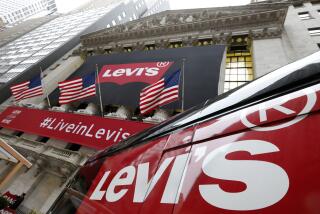Levi Strauss Offers Year’s Pay as Incentive Bonus
- Share via
Offering its workers by far the largest incentive program ever, jeans maker Levi Strauss & Co. on Wednesday proposed to reward each of its 37,500 employees worldwide with a one-time bonus equal to about a year’s pay if the company meets its performance goals over the next six years.
The plan, which Levi valued at $750 million, was unveiled to 2,000 cheering employees at a morning rally outside the venerable company’s San Francisco headquarters.
“Motivated employees are our source of innovation and competitive advantage,” said Chairman Robert D. Haas. “By acknowledging and rewarding their efforts, we not only demonstrate our appreciation but also encourage them to continue striving for new standards of excellence.”
The initiative by the world’s largest apparel company comes in a year when big businesses such as AT&T; have been lambasted for massive layoffs and other rough-edged personnel practices. Levi Strauss itself drew criticism Wednesday for failing to extend bonuses to workers at Third World contractors that help produce its merchandise.
But many observers say Levi Strauss’ new program could encourage other companies to develop more aggressive approaches for rewarding workers. To date, companies have offered such incentives as profit-sharing, stock purchase programs and the granting of options to buy stock. The Levi program is unique in its generosity and scope.
The Clinton administration, which has recently embarked on a “corporate citizenship” campaign, lauded the action. The administration has urged businesses to improve their profit-sharing and employee benefits programs, invest more money in job training and adopt policies that help workers balance the demands of job and family.
In a prepared statement, Labor Secretary Robert Reich said the move “appears to be a shot in the arm for corporate responsibility. Today’s winning companies stand by their employees in good times and bad, and they share gains with those in the boardroom and on the factory floor.”
The plan stunned even union representatives who have worked closely with Levi Strauss management. Frank Nicholas, a vice president of the Union of Needletrades, Industrial and Textile Employees, said workers had been concerned that a recent financial overhaul would enrich the company’s owners at the expense of many employees.
But, he said, “we were flabbergasted when the company came around and said they wanted to share the wealth.”
Observers noted that Levi Strauss, which already has enjoyed a “good guy” reputation for its treatment of employees, undoubtedly figured that the gesture would reap a huge bonanza of goodwill--a crucial factor in the image-conscious fashion business. Levi’s work force has endured four years of an internally disruptive program to redesign manufacturing and distribution processes to make the company more responsive to customers.
“We’re delighted, and it shows Levi’s commitment to share its success with employees--not just some employees but all employees,” said one worker at Levi’s Plaza, who, like many colleagues there, declined to be named.
During its 145-year history, the company has been recognized for its philanthropy and its progressive human resources policies. In 1992, for example, Levi’s became the first Fortune 500 company to offer full medical benefits to all unmarried partners of its employees. It also has flexible time-off policies--including Friday afternoons off during summer months--to help employees balance their work and personal lives.
“Levi’s has for a long time been designing programs that make them an employer of choice,” said Paul M. Sanchez, a San Diego-based senior consultant with Watson Wyatt Worldwide, a consulting firm. “This is a natural outgrowth of thinking hard about how a company and its employees can work together.”
David Lewin, a management professor at UCLA’s Anderson School, viewed the bonus plan as encouraging for the nation’s beaten-down work force, which has been subjected in recent years to a more or less steady diet of depressing news about layoffs.
“It is possible that a corner is being turned,” Lewin said. “[Some] companies are now saying, ‘You will be around long enough to receive this.’ It implies work force stability.”
Lewin said Levi’s program might encourage other companies to think of innovative--albeit less generous--ways to reward and retain rank-and-file employees, instead of just top executives, whose lavish pay packages have come in for criticism.
“There is definitely a movement in many major companies to get more focused on a team-based orientation,” said Gary Hourihan, president of Strategic Compensation Associates, a Los Angeles consulting firm.
However, the Levi plan drew fire from a human rights group that has previously tangled with the company. The Canadian Catholic Organization for Development and Peace said the company’s plan does not go far enough because it will not cover thousands of workers employed in sewing shops used by Levi or its contractors in an estimated 50 countries.
Levi, maintained Jacques Bertrand, a coordinator for the group, sells merchandise produced in Honduras by employees who make less than $2.50 a day and are forced to work overtime.
In recent years, Levi has undergone dramatic changes. As part of the “re-engineering” effort now underway, most workers are reapplying for newly created jobs. In April, Levi borrowed more than $3 billion to buy back shares from employees and other shareholders, ensuring that the company would be owned by descendants of founder Levi Strauss well into the next century.
Levi Strauss, which manufactures and markets jeans and casual sportswear under such names as Levi’s and Dockers, had sales of $6.7 billion in 1995.
For employees to receive the full bonus, the company must achieve a “cumulative cash flow” of $7.6 billion by November 2001, a goal that company officials said they expect to exceed. The $7.6-billion target refers to cumulative earnings before interest, taxes, depreciation and amortization.
The company, which is privately held by the Haas family, had cash flow last year of $1.09 billion. The company would have to achieve about $1.3 billion per year in the next six years to make its goal.
A company spokesman noted that this is not an all-or-nothing deal. If the figure comes in even a couple of billion dollars below the target, employees would be eligible for a partial bonus. Likewise, if the target is exceeded, they could receive even more than a year’s pay.
Assuming the goal is met, employees who retire before the end of 2001 would receive a prorated amount. Other workers who leave voluntarily would have to work for at least half the six-year period to receive any portion of the bonus.
Times researcher Norma Kaufman in San Francisco contributed to this story.
More to Read
Inside the business of entertainment
The Wide Shot brings you news, analysis and insights on everything from streaming wars to production — and what it all means for the future.
You may occasionally receive promotional content from the Los Angeles Times.











